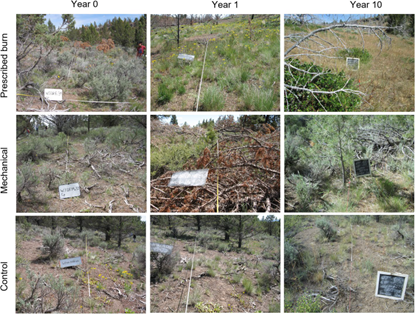Fuel Loadings
All aboveground plant material is flammable, and we measure this fuel through time to see how fuels accumulate after treatment. In the shrubland network, both prescribed fire and mechanical treatments reduced fuel loads at 10 years after treatment, resulting in reduced potential for high intensity wildfire. In the woodland network, however, fuels recovered more quickly. The increase in herbaceous fuels actually increases the potential for surface fire in the short term, but prevents the risk of fire moving through the woodland canopy.
Latest Resources on Fuels
View synthesis. Our review revealed tradeoffs in woody fuel treatments between reducing canopy fuels vs. increasing understory herbaceous vegetation (fuels) and fire behavior. In pinyon-juniper expansion areas, all treatments decreased crown fire risk. Prescribed fire and cut and broadcast burn treatments reduced woody fuels long-term but had higher risk of invasion. Mechanical treatments left understory…
View article. Sagebrush ecosystems of western North America are threatened by invasive annual grasses and wildfires that can remove fire-intolerant shrubs for decades. Fuel reduction treatments are used ostensibly to aid in fire suppression, conserve wildlife habitat, and restore historical fire regimes, but long-term ecological impacts of these treatments are not clear. In 2006, we…
View article. Over the past century, pinyon and juniper trees have encroached into sagebrush steppe lands of the interior United States, and managers have for many years removed trees to stimulate the favored understory. While consistent understory response to tree removal in these semiarid lands suggests that trees outcompete other plants for water, no studies…

